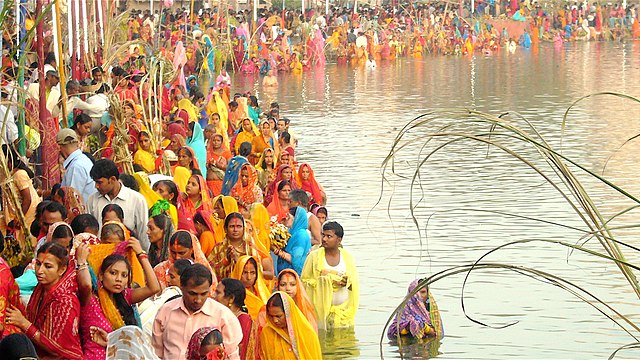Kalicharan Tuvij
Ästika
In the eastern region of India (esp., Bihar-Jharkhand) the all-important festival, Chatha Puja, is underway. So I thought sharing some known and unknown facts regarding Chatha Puja.
Chatthi Maiya is the Deity worshipped, by all sections of the society, on the evening of the day and the very morning of the next day. That is, Surya is worshiped in His setting and rising forms. In Veda they are separate deities: Ratri and Usha.
{Ratri-Usha, combined, is also known as AsviniKumar, and He is invoked before worshipping any deity}.
Chattha is a Vedic festival. In the post Vedic, Draupadi is known to have celebrated this festival. And, yes, it is women who perform all rituals, have personal relation with Maiya, and indeed all family and community revolve around and support them in this endeavor.
Ratri and Usha are worshipped by women standing in the running water of a river, preferably Ganga, by offering "water yagya" (called arghya) to Ratri (setting Surya) and Usha (rising Surya the next morning). Ofcourse, before this, there is procession of sorts where thousands of people move towards the nearest river, led by their women.
Who is Chatthi MaiyA?
She is the female form of Lord Indra (the "sixth"/ chatthA) Himself. The symbology of Indra making "rivers" run through Usha-Ratri is also apparent.
Of course, the much maligned Lord Indra (by post vedic retards) is not consciously worshiped here; but names are hardly important, people do what they do, irrespective of everything, and get what they pray for.
History tells us Biharis have always led BharataVarsha in times of distress. Last time it was ChandraguptaMaurya and Chanakya, and no doubt the last word has not been spoken yet. Indratva very much thrives in this region.
That women are the movers in this most important puja also says a plenty about the Vedic culture.
Jai Chatthi MaiyA
KT
Chatthi Maiya is the Deity worshipped, by all sections of the society, on the evening of the day and the very morning of the next day. That is, Surya is worshiped in His setting and rising forms. In Veda they are separate deities: Ratri and Usha.
{Ratri-Usha, combined, is also known as AsviniKumar, and He is invoked before worshipping any deity}.
Chattha is a Vedic festival. In the post Vedic, Draupadi is known to have celebrated this festival. And, yes, it is women who perform all rituals, have personal relation with Maiya, and indeed all family and community revolve around and support them in this endeavor.
Ratri and Usha are worshipped by women standing in the running water of a river, preferably Ganga, by offering "water yagya" (called arghya) to Ratri (setting Surya) and Usha (rising Surya the next morning). Ofcourse, before this, there is procession of sorts where thousands of people move towards the nearest river, led by their women.
Who is Chatthi MaiyA?
She is the female form of Lord Indra (the "sixth"/ chatthA) Himself. The symbology of Indra making "rivers" run through Usha-Ratri is also apparent.
Of course, the much maligned Lord Indra (by post vedic retards) is not consciously worshiped here; but names are hardly important, people do what they do, irrespective of everything, and get what they pray for.
History tells us Biharis have always led BharataVarsha in times of distress. Last time it was ChandraguptaMaurya and Chanakya, and no doubt the last word has not been spoken yet. Indratva very much thrives in this region.
That women are the movers in this most important puja also says a plenty about the Vedic culture.
Jai Chatthi MaiyA
KT

